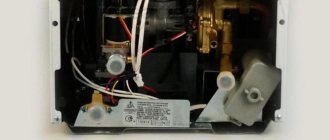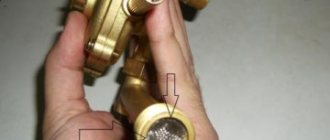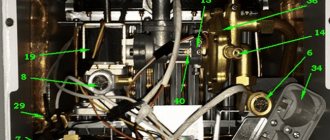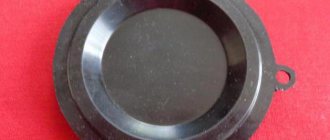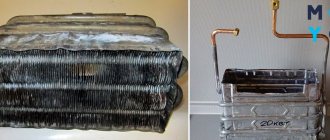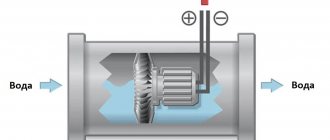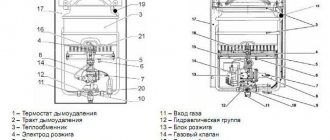Geysers are reliable water heating devices, however, like other devices, they have wear parts. Therefore, there are times when the water stops heating. If the reason for this is a leaky membrane for the geyser, then it is not necessary to invite a specialist to repair it. You can do the replacement yourself, don’t you agree? But what is needed for this and where to start?
In this article we will analyze in detail the process of replacing the membrane and the features of repair work for different generations of speakers. But first, let’s get acquainted with the structure of the water block, which will have to be dismantled and disassembled in order to get to the membrane. We will provide replacement instructions with visual photos, useful tips and videos with an example of replacing the diaphragm of various speakers.
Purpose and structure of the water unit
The membrane is an important part in regulating the gas supply. To understand its purpose and operating principle, you should study in detail the structure of the water block of the column, of which it is a structural element. This knowledge will help when replacing the membrane, because in order to get to it, you have to dismantle the entire assembly and disassemble it.
We also recommend that you become familiar with the general structure of a geyser to make it easier to find a water block in its design. But first things first.
Water reducer device
One of the components of almost any gas heat exchanger is a water reducer (water unit - WU, water regulator). It is designed to regulate the uniform supply of water and gas. The practically designed shape of the regulator (in common parlance – “frog”) facilitates compact placement of the unit in the speaker body. The technically simple device works automatically.
The functions of the gearbox are as follows:
- starting and stopping the operation of the gas water heater when opening/closing the tap;
- regulation of water and gas supply;
- protection of the column from overheating when there is insufficient water pressure.
The design of the gearbox is well thought out and visually uncomplicated. The body is made of brass, polyamide (containing fiberglass), silumin or plastic.
Parts of the water unit: cover (1) and base (2), connected with screws; plate (4); rod that opens/closes the gas valve (5); membrane (6); Venturi fitting (7); gland nut (8); water outlets (9); adjusting screw (10); mounting screws (3); strainer (11); retarder ball (12)
Operating principle and importance of the regulator
The hollow cavity of the gearbox, divided in two by a membrane, is filled with water. Water enters the cavity from the water supply. From the lower part, passing through the Venturi fitting, it enters the upper compartment through the bypass hole. However, water coming from the water supply to the lower part always presses on the membrane with the force of water pressure in the pipeline, and in the upper part the pressure force changes, depending on whether the water flows through the heat exchanger.
The fact is that in pipelines that have narrowed sections, the pressure of the flowing liquid in a bottleneck decreases. When the tap is opened and water passes through the Venturi fitting, the pressure in front of the local narrowing (nozzle) of the fitting increases.
Due to the increase in flow velocity in a bottleneck, the pressure decreases both in the fitting and in the upper cavity of the frog. This is similar to flattening the end of a garden hose. With a difference in the diameters of the nozzle of the fitting (0.3 cm) and the main chamber (2 cm), the pressure drop reaches 1 atmosphere. This is enough for the membrane to bend upward and press on a plastic plate rigidly fixed to the axis of the rod. The rod presses forcefully on the gas valve, causing the valve to open and gas to flow to the gas burner.
When the membrane is lifted, water from the upper compartment begins to exit through the bypass channel, where the steel retarder ball is located. The ball, moving to the right, partially blocks the channel, so the gas is turned on and supplied to the burner smoothly. Smoothness is adjusted using an adjusting screw.
The Venturi nozzle is located in the outlet pipe (on the right side of the frog). This is a local narrowing that provides a pressure drop when the tap is opened. A clogged fitting must be cleaned
When the hot water (HW) tap is closed, the flow of water stops and the pressure in the Venturi nozzle is compared with the pressure in the cavity under the membrane. Due to the action of the springs, the rod together with the plate moves down, and the membrane returns to the middle position.
The gas valve closes automatically. The gas valve is turned off quickly, since the reverse flow of water in the culvert moves the ball to the upper cavity (to the left) and ceases to impede the flow of liquid. We recommend that you look at the information on what to do if the gas valve does not work.
If the hot water flow rate is less than 2-3 l/min, the required pressure drop does not occur, and the springs do not allow the rod to open the gas valve at all or enough to fully heat the water. Also, the necessary pressure difference does not arise when the integrity of the membrane is violated.
The water regulator, based on the principle of operation of the Venturi nozzle, is a safety device, as it allows the water heater to be turned on only when there is sufficient water flow through the heat exchanger. Thus, the reducer automatically protects the geyser from overheating.
The overflow hole connects the Venturi nozzle and the upper cavity of the frog. This hole must be left open when installing the diaphragm for the gearbox to operate correctly.
Replacement
It is quite possible to replace a damaged membrane in a flow-through heater with your own hands:
- Turn off access to water and gas to the device.
- Open the hot water tap to relieve pressure.
- Remove the column casing by unscrewing the mounting screws.
- Locate the water regulator along the cold water supply pipe.
- Unscrew the nuts that secure the regulator to the water pipes, as well as the screws that secure the part to the gas part.
- Remove the regulator and disassemble it.
- After replacing the membrane, reassemble the column in reverse order.
Related article: Country house styles
To see the entire process of replacing the membrane, see the video below.
Reasons for diaphragm failure
Membranes are consumables with a service life of 5-8 years (on average). The elasticity of the material decreases over time. As a result of the action of alternating stresses, fatigue occurs over time in each material subject to bending—the formation and accumulation of damage. If the membranes operate in an intensive mode, when the gas water heater is used frequently and a lot, fatigue occurs earlier. Microcracks appear in the body of the diaphragm, then breakthroughs form.
The scale that forms inside the frog also contributes to rapid wear of the diaphragm. Another reason is the use of clandestinely produced diaphragms. Often such products are made from low-quality rubber.
Therefore, information on how to properly replace the membrane in a household geyser if it fails will come in handy. With such knowledge, you can repair the water unit on your own, without involving specialists.
This is what the water reducer looks like after removal. As a result of grooving the oil seal, scale formed on the rod and its nut, which is removed during the process of replacing the diaphragm
Membrane Failure Determination
The operation of the gas water heater may deteriorate gradually or stop instantly. The malfunction does not always lie in the wear of the rubber heart of the water block. Sometimes the reason is extraneous. Therefore, before you start with a screwdriver or a key to the insides of the unit, it is more rational to diagnose it.
Diagnosis of the reason for the automatic shutdown of the column
Column failure can occur for various reasons. Therefore, if a column malfunction is detected, you should not immediately begin dismantling and disassembling the water unit.
The column automatically turns off in the following cases:
- there is no draft in the chimney;
- the heat exchanger overheats;
- the flame above the gas burner does not ignite;
- The membrane does not work properly.
We gave other reasons why the column attenuates in the following material.
In modern household heat exchangers equipped with digital displays, the main control board displays an error code expressed in numbers on the screen. He will tell the technician what to check first.
This is not the case with older devices. The error code won't mean much to the average user. Therefore, when searching for the cause of a breakdown, you should be guided by a practice-tested method - the method of verification and exclusion.
Checking the correct connection of communications
So, first you need to make sure that there is water in the water supply network at home, the gas inlet is not blocked, the valves supplying water and gas to the water pump are open in operating mode, and the batteries are not dead.
The problem with the geyser not working may well be banal batteries - if they are dead or the contacts are oxidized, then the geyser will not turn on
That is, you need to find out whether the column has turned off for reasons independent of its performance.
- Check the water pressure in the water supply and the presence of natural draft in the chimney. To enable the membrane to operate, the water flow must be at least 2-3 liters per minute. We talked about the reasons for weak pressure here.
- Clean the contacts of the power compartment, replace the batteries.
- Imported units are sensitive to how the phase is located in the sockets. Reverse the position of the plug in the socket.
- Check fuses.
- If a filter is installed on the cold water supply pipe, check whether the filter is clogged. You should also check the mesh installed on the faucet tap. Clean if dirty.
- Check for a spark at the ignition electrodes when the hot water mixer is on. In units with a closed chamber, the clicking of the discharges can be heard from the outside. The presence of a spark means that the membrane is triggered.
Once you are convinced that the reasons for the main valve failure lie within the system, proceed to further diagnostics.
How does a membrane malfunction appear externally?
In some GC models, the rod, including the column, is located above the body, so the movement of the rod can be observed. If the rod does not move or does not extend completely, then the membrane and plate should be checked for integrity. On some models, the movement of the rod can be seen when the housing is removed.
If, after cleaning the filter mesh, the gas burner does not fire, but ignites only when the hot water tap is fully opened or several such taps connected to the hot water valve are opened at the same time, then it will be necessary to replace the old gas water heater diaphragm with a new one.
By installing a mesh filter on the inlet pipe, you will protect the elastic gasket from accelerated destruction. Silicone membranes, which can withstand tensile and bending stresses many times greater than rubber parts, are especially sensitive to mechanical abrasion
During normal operation of the membrane, the flames rise 3-5 cm and are located exactly above the edges of the burner. Otherwise, especially if cleaning the nozzle did not help (if ignition is carried out from the wick), the culprit may be a leaky diaphragm. This is also the most likely reason if you do not hear characteristic clicks from the batteries when you ignite the speaker.
A red, high flame may indicate that the gas is not suitable. If a blue flame, burning sluggishly, produces hot water at first, then rapidly cooling water, we have another symptom of a “membrane disease.”
The gearbox must also be disassembled if water leaks from the water block. This malfunction can be caused by scale, wear of the gasket on the screw bushing of the rod, failure of the membrane itself or the plastic parts of the combined membrane.
Indications for repair
During the use of the column, due to the pressure on the membrane and the hard water entering the device, small cracks and areas of deformation appear on the diaphragm. To see them, you need to remove the membrane and inspect it carefully. Quite often, an assessment of the condition of the diaphragm and its subsequent replacement is performed during the annual maintenance of the column.
Problems with turning on the column will tell you that the membrane has worn out before the scheduled check. In this case, you should first make sure that gas is supplied to the column, and that water is supplied with sufficient pressure. If your column uses piezo ignition, clean the pilot burner(s). If after such cleaning the device does not turn on, most likely the membrane is damaged and the device needs to be disassembled.
If your column turns on via electronic ignition from batteries, when you turn it on and hear clicks, then everything is in order with the membrane, and the problem most likely concerns the gas path or the ignition electrode. If there are no clicks when turning on, damage to the membrane is the most likely cause of failure, which can be easily verified by disassembling the unit.
In some columns, the condition of the membrane can be determined by the rod that controls the switch of the electronic unit. After removing the column casing and opening the hot water, look to see if the rod has moved. If it's the diaphragm, the rod will stay in place.
Related article: How to choose a self-adhesive door seal?
In situations where damage to the membrane is minimal, but increases over time and leads to rupture, water will flow inside the cavities of the water regulator, which leads to the device not operating at all possible power. Gradually the power drops and eventually the speaker stops turning on completely.
Selecting a replacement membrane
Diaphragms are made of elastic material - black rubber or silicone. They can be solid or composite, for example, the product can be rubber-metal or come complete with plastic parts. Most often, diaphragms have a simple round shape. But there are models of geysers whose gearbox membranes are distinguished by a complex, “bizarre” configuration.
You are lucky if the speaker is domestic, and “native” membranes are available for sale. Even luckier is if the required spare part is made of silicone, which means it will last longer (about 10 years). But it is also likely that you will have to purchase a “native” diaphragm through dealers or an online store. You may have to get a full repair kit or a new frog. It all depends on the model of the gas heat exchanger - not all gearboxes have the same operating principle.
The figure-of-eight membrane for Ariston Fast GIWH dispenser gearboxes has a shape that is difficult to replicate. It is more practical to have such a membrane in reserve
European companies produce water heaters with membranes whose shape is difficult to fake. In the worst case, if spare parts for “foreign cars” are not supplied, you will have to buy a new speaker or invent something and make something from the means at hand. There are universal diaphragms that fit a wide range of models.
If you have to wait for a membrane suitable for the column to be sent, and the column diaphragm does not have a complex configuration, you can make a part yourself for a temporary replacement. Rubber 1.5-2 mm thick is suitable, for example, from thick dielectric gloves or an old car camera.
Using the old product as a template, cut out a new gasket. Holes for the bypass channel and screws are made with a punch from a metal tube with a thin wall. The diameters of the bypass hole of the lid and the diaphragm must be equal so that the flow of water between the cavities of the frog is not hampered.
Types of membranes
There are membranes of a special shape, the principle of operation of which is different from the standard scheme. A striking example of such a part can be the consumables for the Ariston Fast GIWH water heater. It is called "eight".
It is cast in a special mold using dense black rubber. The average market price can range from three hundred to five hundred rubles, depending on the place of purchase.
The partition of a household appliance from Electrolux or Vaillant is much simpler. Created on the same principle as the “eight”, it costs only two hundred to two hundred and fifty rubles.
There is an even simpler type, for example, a membrane for a geyser from the company Neva or Astra. Despite its external unpretentiousness, the part copes with its functions perfectly. An additional advantage of this form is the ease of replacement.
Detailed replacement instructions
Next, we’ll look at how to properly replace the diaphragm. But before starting work, it is important to remember that working with gas equipment belongs to the high-risk class. Therefore, repairs to the column must be carried out by a qualified specialist.
You should not overestimate your skills and strengths - if in doubt, you need to contact the gas service. It is also necessary to contact gas specialists if you smell gas in the room, because if safety measures are ignored, the dispenser may explode.
Stage #1 - preparatory work
First of all, cut off the flow of gas and cold water to the column. The gas must be turned off before starting work, even if you do not plan to inspect the gas part of the equipment. The water unit is connected to the gas unit, and if you touch it, you can get into big trouble.
Water is drained from the system by opening the tap into which hot water flows from the boiler. If several hot water taps are connected to it, open the one located below the device. Then the maximum amount of water will drain from the system. To drain the remaining water, place a basin under the water regulator.
There is no need to mention that the replacement membrane needs to be purchased ahead of time. It is also better to purchase gaskets to seal the rod and union nuts of both pipes. You can purchase a complete repair kit.
It is best to install a silicone membrane when replacing. This is not easy to find right away for all modifications of geysers. Often you have to take the option from stock that suits your speaker model
Prepare tools for work: screwdrivers, wrenches or gas wrenches, pliers. Fine-grit sandpaper may be useful. It is also worth stocking up on rags and a rust dissolving agent (frog screws often turn sour).
To open access to the water unit, open the column housing. Removing the casing is usually not difficult; it doesn’t take long to find and unscrew the mounting screws.
Finding the water regulator is also not difficult - it is the first block on the path of cold water entering the column.
The water regulator of the Neva Group of Companies is located under the gas block. On the left, cold water enters the reducer through the inlet pipe. Through the right outlet pipe from the frog, water flows to the heat exchanger
Stage #2 - step-by-step description of membrane replacement
You can get an idea of the process of replacing a worn membrane in a gas water heater using the example of a household flow-through heat exchanger “Neva”.
When unscrewing the union nut of the outlet pipe with a wrench, as well as unscrewing the screws connecting the water block to the gas block, hold the frog with your hand
Next, consider the process of dismantling the water unit:
- Armed with a wrench, first unscrew the union nut of the inlet pipe on the left side of the gearbox. We take the phone away so that it does not interfere with further actions.
- Holding the frog with your hand, unscrew the nut of the outlet pipe. Let the water drain.
- Using a screwdriver, unscrew the three screws connecting the water and gas blocks. It is not necessary to completely unscrew the fastener; just release the rod. We remove the gearbox.
Now we unscrew the screws securing the cover and base of the block (8 screws). If the bolts are soured, use WD-40. We open the cavity of the block and remove the damaged membrane.
We inspect the condition of the removable parts - plates, rod and bushings, filter mesh, fittings. If necessary, clean the cavity and other surfaces of the frog and its parts from scale or rust. We replace unusable parts or install old parts in the appropriate places.
It is important not to forget to check the condition of the retarder ball. Just shake the lid like a rattle and listen to whether the rolling steel ball is knocking
We install the membrane, not forgetting to accurately align the hole in the rubber part with the hole in the bypass channel. If the channel is blocked, then water will not flow into the upper cavity. The water pressure on the gasket from below will keep it in a curved position, the gas will be open by the rod even when there is no water flow.
We return the cover to its place, install and tighten the fastening screws crosswise (one against the other). After making sure that everything was done correctly, tighten all the screws in the same sequence.
Then we install the assembled block:
- We mount the gearbox in the reverse order. It is advisable to install new sealing gaskets with a diameter of half an inch on the pipes.
- We check the quality of the connection by opening the hot water tap. If there are no leaks when the tap is open, turn off the water and check for leaks under pressure. Then turn on the gas supply. After applying a soap solution to the gas connections, we check for gas leaks.
- If no leaks are found, we check the column in all operating modes.
After making sure that everything is done correctly and the column is working, we mount the removed housing cover.
The gearbox should be dismantled in the sequence indicated by the numbers, tightening all connections in turn. Only after completing this step can you carefully remove the water block. After replacement, its installation should be performed in the reverse order.
Stage #3 - putting the entire water block in order
To avoid the situation that you replace the gearbox gasket, and in a few days you will need to disassemble the water heater to eliminate another malfunction, it is more rational to linger and do preventive maintenance.
While the gearbox is removed, in addition to replacing the membrane, you need to check the ease of movement of the rod. The rods of the water and gas units interact.
Due to leaks, the gearbox rod may become covered with scale or become sour. It must be cleaned, polished with 240-grit sandpaper, and lubricated with mineral oil, such as lithol. The stroke of the rod should be smooth and easy.
It would be a good idea to inspect the stem bushing and seals to prevent leaks. The seal on the stem bushing must be changed periodically. In order to change the seal, unscrew the nut and remove the bushing. If there is scale, it is cleaned off. After replacing the seal, reassemble the assembly in the reverse order. The rod seal should be replaced every three years.
You should also check the Venturi nozzle (fitting) for cleanliness. Even slight contamination greatly affects the performance of the frog. You can clean the fitting with a thin wooden stick. The O-rings on the Venturi tube may need to be replaced.
Then it is advisable to check the following elements:
- Check the operation of the magnetic switch button. If the button is working, but the burner does not ignite due to lack of gas supply, the reason may lie in the reed of the switch. It can be slightly pressed to ensure a tight fit.
- Replace the defective filter mesh or install a new one if it was missing before.
Preventative inspection of the water unit should be performed at least once a year. Likewise, you should not forget about cleaning and regular maintenance of all structural elements of the gas water heater.
How to change the membrane of a gas water heater Neva 3208
1. First, we need to dismantle the body of the water heater to gain access to the water part and more, this is easy to do. Remove the throttle control knob. Under it there are two screws that should be unscrewed using a pre-prepared screwdriver (-). The body itself can be removed quite simply, you’ll figure it out.
After removing the casing, you have free access to all components of the gas water heater. You will be able to visually inspect the gas water heater for mechanical defects, as well as clean it from dust and dirt. If such measures to clean the water heater and its main burner are carried out once a year, then you will reduce the frequency of calling a technician for emergency repairs of the gas water heater by half.
2. Below in the photo the arrow indicates the water part. The geyser membrane is installed inside this mechanism, so in order to change it we need to dismantle and disassemble it.
3. Using an adjustable wrench, unscrew and disconnect the tubes from the water part. When unscrewing, water may flow out, do not be alarmed, these are residues. Prepare and set out some dishes in advance.
4. After unscrewing the tubes, we should disconnect the water part from the gas block. Unscrew the three mounting screws and lightly hold the water assembly with your hand. If the water unit is not “stuck” to the gas block from oxide and rust, it should come out freely and remain on the palm.
Most geysers, from the ancient KGI-56 to modern imported ones with a bunch of smart electronics, contain a rubber membrane that separates the cavities of the water regulator. And sooner or later this membrane breaks. Is it possible to replace the membrane in a geyser with your own hands? Well, nothing is impossible!
Damage to the membrane in a geyser is a fairly common and simple malfunction, so a skilled person can easily handle it with his own hands.
Please note that according to the operating instructions, geyser repairs must be carried out by qualified personnel. Attempts at self-repair without the necessary knowledge and experience in servicing gas equipment can lead to equipment damage and gas leakage. Don't overestimate your strength. If you have the slightest doubt, contact gas service specialists.
How to determine a membrane failure?
Damage to the membrane is one of the most easily diagnosed geyser failures. First, make sure that the water and gas pressure is sufficient for normal operation of the column. The flow rate through the hot water tap should be at least 2-3 liters per minute. Gas pressure can be assessed by eye, by the shape of the flame in the burners on a gas stove.
For speakers with wick ignition
Check the size and position of the pilot burner flame. The flame should be 3-5 cm long and positioned exactly above the edge of the main burner. If this is not the case, then it is necessary to clean the pilot burner nozzle. If even after this the column does not light up, then most likely the problem is in the membrane.
For speakers with battery ignition
It is necessary to check the ignition attempts. If the column tries to turn on (clicks are heard), then the membrane is in order; the reason must be sought in the ignition electrode or gas part. If there are no clicks, there may be several reasons, but membrane rupture is the most likely cause and can be easily verified by disassembling the unit.
In some speaker models, the serviceability of the membrane is checked by moving the rod that controls the microswitch of the electronic unit. This is clearly visible when the column casing is removed. If the rod does not move when you open a hot water tap, then the problem is definitely in the membrane.
Membrane rupture
It can happen suddenly, or it can develop gradually. In this case, a small crack first forms, through which water flows between the cavities of the water regulator. The pressure drop drops and the column cannot turn on at full power. Gradually everything gets worse and worse and, finally, the column does not turn on at all.
How to choose a membrane for a geyser?
The next step is to select a membrane
for replacement. For some models of geysers, especially for imported manufacturers, there is not much to choose from. You can purchase the membrane only from the manufacturer’s dealer and often at an inflated price. And sometimes even this is not possible because spare parts are simply not supplied. At this point you will have to change the entire column or come up with a solution using improvised means.
For more common models, membranes can be purchased from local or online stores that sell spare parts for gas equipment. The price of the membrane depends on its design and material used, as well as the prevalence of the geyser model.
Some membranes are quite complex and tricky. Here, for example, is the membrane for the Ariston Fast GIWH geyser, the so-called “figure eight”.
It is produced only in this version, made of black rubber and costs 300-500 rubles, depending on the seller’s appetite.
Membranes for geysers Electrolux GWH or Vaillant MAG are much simpler. These are also products made of black rubber, their cost is 200-250 rubles.
Some types of membranes are suitable for both imported and domestic geysers of recent years of production. Here, for example, is the membrane for the NEVA Lux 5013 (5016) geyser, exactly the same one used in the MORA 5502-5507 columns. The cost of such a membrane is 150-200 rubles.
At a slightly more expensive price (200-250 rubles), such a membrane can be purchased assembled with plastic parts adjacent to it. If the column has worked for more than 5 years, then this is exactly what you should do; plastic parts become brittle over time due to leaching of plasticizers.
There are also rubber-metal membranes, for example, for the NEVA Lux 5513 (5514, 6011, 6013, 6014) geyser. These are more expensive, 200-300 rubles.
But the widest selection is offered for old gas water heaters VPG-18, VPG-20, VPG-23, NEVA 3208 (3210, 3110, 3112), Darina and Neva 4510 (4511, 4513). And this is where it’s worth thinking.
If there is an alternative, then it makes sense to give preference to a silicone profiled membrane
.
This material itself is very resistant and elastic, and the shape of the membrane allows it to work not by stretching, but by bending. A silicone membrane costs 50-100 rubles, and can work in more or less clean water for at least 10 years. The photo shows the original membrane from the Neva-3208 gas water heater, produced in 2002. She has been working non-stop for twelve years now and has no intention of giving up.
Thick profiled membranes made of black rubber
. They cost about the same as silicone ones, but last a little less - 5-8 years, if there are no defects.
And just out of desperation, you can install a flat white membrane made of vacuum rubber
. These were installed in old speakers like KGI-56, and even now, no, no, and they are offered, including for the Neva-3208.
No, such a membrane will work, but for how long? It works by tension and most often lasts no more than a year. There is no point in buying such a membrane for more than 30-50 rubles.
Sometimes membranes made of thin red rubber
. Just from the quality of workmanship it is clear that they are produced almost in a handicraft manner; the holes are uneven with burrs and cracks.
You can take a risk and bet, especially if there are no other options, but there are reviews on the Internet about the rupture of such membranes the first time you turn on the column. Again, nothing bad will happen, you’ll just have to disassemble the column again and install another membrane.
Sometimes it happens that it is not possible to purchase the right membrane right away, because delivery from online stores takes at least several days. In this case, if the membrane is not too complex, a temporary membrane
from more or less suitable material. Rubber 1.5-2 mm thick from a car inner tube or thick household gloves is suitable. Please note that the material must stretch, so rubberized fabric will not work.
The membrane is simply cut out with scissors, using the old one as a template. It is better to make holes with a punch made of a thin-walled metal tube. Pay special attention to the hole in the bypass channel
. It can be distinguished by its increased diameter and “illogical” location in the space between the mounting holes.
This hole must be clean and of the required diameter so that when assembling the water regulator it does not block the bypass channel.
By the way, if you have to purchase a membrane through an online store, do not rush. Spend half an hour or an hour searching and you will be surprised how much you can save. For example, there are online stores offering a simple rubber membrane for the Neva-3208 column for 550-650 rubles. If you search a little, you can buy the entire water regulator for Neva-3208 assembled for almost the same price!
How to replace the membrane?
The process of replacing the membrane in a gas water heater is most often simple. First of all, you need to turn off the column and shut off the supply of cold water and gas. It is also necessary to open one of the hot water taps to relieve pressure in the pipes.
a little trick here
— you need to open the tap that is located below the column, usually a mixer in the bathroom. Then, during disassembly, all the water in the heat exchanger and pipes will drain through the open tap due to the siphon effect. If you open the tap in the kitchen and it is higher than the location of the water regulator, then 3-5 liters of water will pour out onto your feet.
Now you need to remove the casing of the gas water heater. The mounting points for the casing are different for each model, but most often they are not difficult to find. Sometimes the mounting screws are located under decorative trims or speaker control knobs.
In some cases, there is no fastening at all, and the lid simply hangs on hooks. After removing the casing, access to the internal structure of the column opens. You can start replacing the membrane.
In older speaker models, the membrane is located in the water regulator, which is made as a separate part. Finding a water regulator is very simple - this is the first thing that includes a pipe that supplies cold water to the column.
To remove the water regulator, simply unscrew the two union nuts securing the water pipes and the three screws securing the water regulator in the gas part. After this, the water regulator is simply pulled down.
In more modern geysers, which provide automatic adjustment of hot water temperature and ignition from batteries, the design is rotated 90 degrees. But to remove the water regulator, you also need to unscrew the union nuts on the pipes and the fixing screws.
Also common are geysers in which the gas and water parts are combined into a single unit. This, for example, was done in the MORA 5506 column and the similar NEVA Lux 5013.
The water regulator cover is located on the right; to remove it, you need to unscrew two union nuts and four T20 head screws (internal sprocket). With some persistence, you can unscrew such screws with a regular flat-head screwdriver of a suitable size, but traces of tampering will remain.
The cover in the photo is shown after cleaning with a solution of phosphoric acid in an ultrasonic bath; usually brass looks much worse after several years of use. However, appearance does not affect performance. (Photos of the MORA 5506 column are taken from a post by user Wladimir_TS on the forum of monitor.net.ru).
Now all that remains is to disassemble the water regulator and replace the membrane with a new one. Pay special attention to correct assembly
— it is important not to place the membrane upside down and not to block the bypass channel connecting the halves of the water unit.
The gas water heater is assembled in the reverse order; do not forget to replace all the gaskets. With some experience, replacing the membrane takes no more than 15 minutes.
Do you know that…
... there are geysers in which there is no membrane at all, for example Nobel FOSS 1. The flow sensor in this case is an impeller similar to the one located in a water meter. It is strongly recommended to install a main water filter with a mesh size of no more than 100 microns in front of such columns, otherwise the sensor will not last long. The same applies to dispensers ignited by a hydrogenerator.
Today, a common way to combat the problem of lack of hot water in a residential area is to install a geyser. Despite the widespread belief about the dangers of using geysers in residential premises, modern water heaters have a high level of safety. The speaker can serve its owners for many years if you use it correctly and ensure that all functional components are in good working order. The membrane for a geyser is an important element that helps heat water.
Replacing old type speaker membranes
There is no stagnation in technology; the designs of modern gas water heaters and old water heaters (GVA, L, VPA) are different. Therefore, there are nuances in replacing the gasket. The following description is given for KGI-56.
KGI-56 columns come from the Soviet Union. They were produced at , starting in 1956. But they can still be found in kitchens in working order.
To replace a worn or stretched diaphragm in the KGI-56, a series of actions are performed sequentially:
- After unscrewing the nut, remove the burner located above the gas block and set it aside.
- Dismantle the gas block by disconnecting it from the gas pipe and loosening the three screws that connect it to the water block. When unscrewing the union nut, hold the gas block with your hand.
- Unscrew the bolts securing the water block housing cover. Remove the cover.
- Replace the worn part, insert screws (to facilitate subsequent screwing), and install the gearbox cover in place. The screws are first tightened, doing this in opposite pairs, then tightened in the same order.
- Install the gas block, then the burner.
Be sure to place a basin, because when removing the gearbox cover, water will flow out.
Features of membrane replacement in new models
The water units of modern speakers work on the same principle. The main differences between new designs of instantaneous water heaters are the saturation of control units, monitoring units, touch screens, and wires.
Some fasteners have changed. For example, now screws are tightened and unscrewed with special screwdrivers with an asterisk. Innovations affected both the shape of the frogs and their connection to the gas block.
On devices Amina, Selena, Milla, Ross (popularly - Chinese), it is better to entrust the replacement of the frog gasket to specialists, since the gas part needs to be dismantled along with the water part
On branded speakers Bosch and Junkers, the water unit is located at the bottom right. To remove it, you need to disconnect the terminal of the draft sensor located in front of the control unit.
Having turned off the water supply to the column and opened the hot water tap, use a screwdriver to remove the bracket that holds the pipe running from the heat exchanger to the heat exchanger. Pulling the pipe slightly to the right from the water unit, wait until the water from the system pours out through the tap, after which the pipe is removed completely. After this, use a wrench to unscrew the nut securing the water block to the water supply.
Brackets are a new type of fastening of structural elements of the water block of Bosch and Jurkers speakers; they are pryed off and released using a screwdriver
Unscrew the VU fastening screws with a Phillips screwdriver. They are located at the bottom of the structure. There is no need to unscrew them completely. After this, the water block is at the owner’s disposal. It can be inspected, cleaned, and consumable parts replaced (the coarse filter mesh can be cleaned without removing the VU).
There are much more consumable parts in such a frog than in the gearbox of the Neva Group of Companies. Firstly, the water block itself is made of plastic, the mounting screws are screwed directly into the plastic (no brass inserts). The connection is not designed for many cycles of assembly and disassembly. If there is a leak along the VU rod, the cover will need to be replaced completely (maximum service life is 2-3 years).
Secondly, in addition to the functions described above, it additionally regulates the amount of water flowing through the column, so a stable liquid temperature is maintained at the outlet of the hot water tap.
In a Bosch water heater, the silicone membrane is a convex cap of complex design that cannot be cut from flat rubber. Just buy, and, moreover, your own one
To regulate the water flow, the lower part of the frog is equipped with additional overflow channels, a faucet, and a mechanical water flow regulator. If the brass valve axlebox is soured, it is replaced with a new one. To replace the diaphragm, you will need to purchase a “native” one. All spare parts for a branded water heater are expensive. It happens that it will be cheaper to select and buy a new speaker than to find the required unit and wait for it to be delivered and installed.
Is it possible to get by with repairing the diaphragm?
DIYers couldn't pass up the opportunity to try and repair a leaky rubber part.
Practitioners have tried the following methods:
- applying patches using various adhesives;
- puttying the surface of the diaphragm with silicone sealant;
- use of silicone compound Pentelast.
Experience has shown that such measures will not help for long, perhaps only for a day or two, since the membrane works under strain. A new failure of it could worsen the situation. Therefore, there is no need to resort to gluing and patching the gasket.
